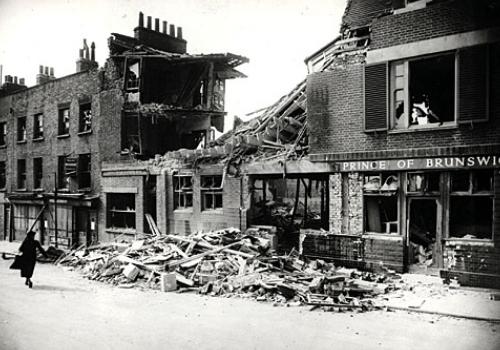Journey from Blitz bombsite to Barnard Park

THE story of the lost streets of Barnsbury – flattened by Second World War bombs and later turned into the placid green square of Barnard Park – is being retold in a new exhibition.
Barnard Park: Conflict, Change and the Urban Landscape, a free exhibition at Islington Local History Centre in Finsbury Library tells how Barnard Park grew out of the devastating destruction of hundreds of homes in the 1940s.
To coincide with the exhibition, Islington Council is searching for former evacuees, who lived where Barnard Park now stands until their streets were bombed on October 9, 1940, to share their memories.
John Shepherd, the archaeologist and historian who worked on the project, said: “The project demonstrates how the town we’re living in today reflects a lot of what happened 60 years ago. We looked at Barnard Park which materialised out of the post-war regeneration and there are still many parts of history visible.
“We did a radar survey and discovered remains of the Victorian houses that were blitzed. Many hundreds of people would have lived there, it was a quite densely populated, run-down area. On October 9, 1940, the warnings came early so people were well aware a big raid might happen at night and many people had taken precautions.”
But, he said, historians found evidence of May Young, who had taken shelter with her two-year-old son Kenneth, and a neighbour at a home in Sheen Grove – one of the streets hit by the bombs. They all perished.
Mr Shepherd said: “We know May was 5ft 4in, slim, Kenneth was 3ft tall, with blond hair and blue eyes. That brings it home that we’re dealing with people like you and me.”
The display traces the history of the lost streets, the effects of the Blitz and how the park came to be built.
It follows a recent project where schoolchildren scanned the remains of Victorian buildings under parkland with the help of a radar.
Their findings, along with old photographs, maps and news cuttings, will be on show until the exhibition closes on March 6.
Islington Council’s leisure chief Cllr Ruth Polling said: “Standing in Barnard Park today, it’s easy to forget that until recently the same land was home to so many people. This fascinating exhibition is a reminder of Islington’s recent past, and I’d invite residents to visit, especially those who live near the park.”
She said she hoped those who remember the bombing of the area would get in touch to share their memories.
• Barnard Park: Conflict, Change and the Urban Landscape, is at the Local History Centre, Finsbury Library, 245 St John Street, EC1. Anyone who remembers the streets where Barnard Park now stands can call 020 7527 7988 or email local.history@islington.gov.uk.
For further information go to www.islington.gov.uk/localhistoryexhibition
RÓISÍN GADELRAB



